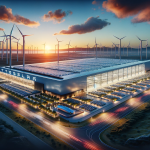In a bold act of defiance against Tesla‘s continued expansion of its Giga Berlin facility, a group of protestors have taken to the trees. Building treehouses in the threatened forest area, these activists signal their commitment to protect the environment and challenge the electric vehicle manufacturer’s development plans. They have created signs such as “Stop Tesla” and “Water is a Human Right,” demonstrating their concerns over the ecological and resource implications of the factory’s growth. This ongoing protest highlights the tension between industrial development and environmental conservation.
The clash between Tesla and environmental activists has been brewing for some time. Similar situations unfolded years ago when Tesla first prepared the Giga Berlin site, encountering warnings about buried World War II ammunition posing safety risks. Back then, specialized teams were sent to secure the area by removing any potential threats. Today, the same safety concerns are resurfacing as protestors occupy the forest grounds, leading to divergent statements from government officials about the presence of unexploded ordnance and the associated dangers.
Risks in the Forest: A Debate Over Safety
Brandenburg’s Interior Minister, Michael Stübgen, has sounded the alarm about potential hazards within the occupied forest, pointing to the possibility of contaminated soil and the risk of forest fires triggered by hidden explosives. Despite these warnings, the protestors view such claims with skepticism, doubting whether these concerns are genuine or merely tactics to dislodge them from their treetop encampments.
Government Officials at Odds
Contradictory opinions emanate from within the government itself. While Stübgen warns of concrete dangers, Environmental Minister Axel Vogel downplays the threat, arguing that contamination and fire risks are minimal provided there’s no digging into the ground. Vogel’s stance appears to support the protestors’ right to remain, provided they adhere to these guidelines. Meanwhile, other political figures, such as Marlen Block, question whether the protestors’ presence is truly unwelcome by the authorities, hinting at broader political motivations behind the public safety discourse.
From a wider perspective, certain reports offer nuance to the unfolding situation. An article by Engadget titled “Tesla’s German factory faces environmental resistance” details the initial resistance Tesla faced over the environmental impact of its Giga Berlin project. Another report from Reuters, “Tesla agrees to cover the cost of water supply for Giga Berlin amid local concerns,” discusses Tesla’s efforts to mitigate the impact of its factory on local water resources and the company’s engagement with the community to address these concerns.
Protestors’ Stance and Rights
Despite facing opposition from various parties, the protestors have maintained a non-violent approach, exercising their right to assembly. They amplify their message of environmental preservation in the face of industrial expansion, drawing attention to the wider implications of Tesla’s footprint in the region.
Useful Information
- Protestors are concerned about environmental and water resources.
- Authorities present conflicting information on safety risks.
- Non-violent protest underlines the right to assembly.
As the Giga Berlin controversy continues, the protestors’ commitment stands firm. Their approach—a blend of environmental activism and civil disobedience—strikes at the heart of a global debate: How to balance technological progress with the preservation of our natural world. This ongoing story serves as a poignant reminder of the complexities that arise when groundbreaking innovation encounters grassroots environmentalism.










